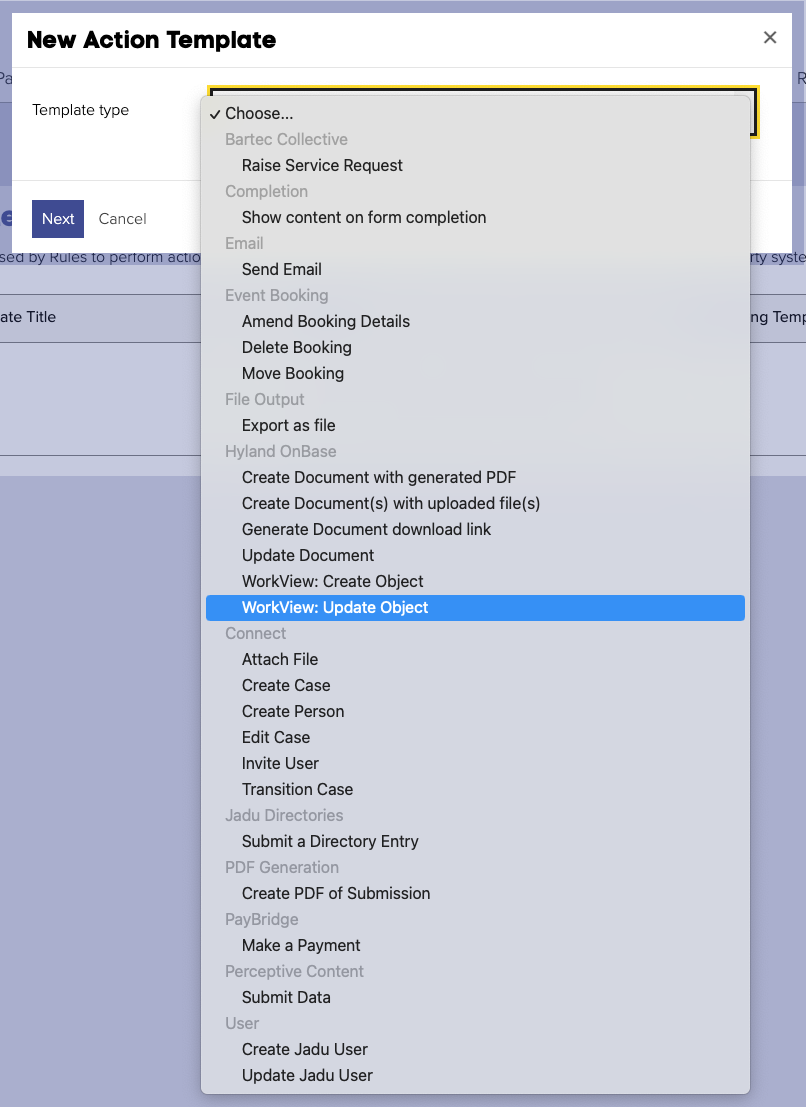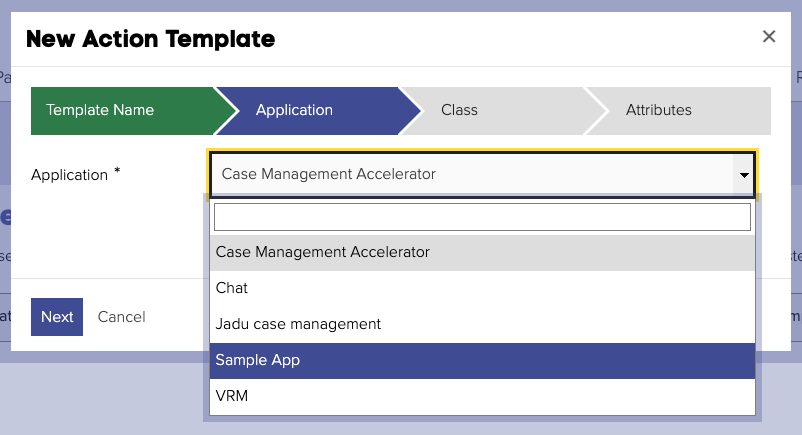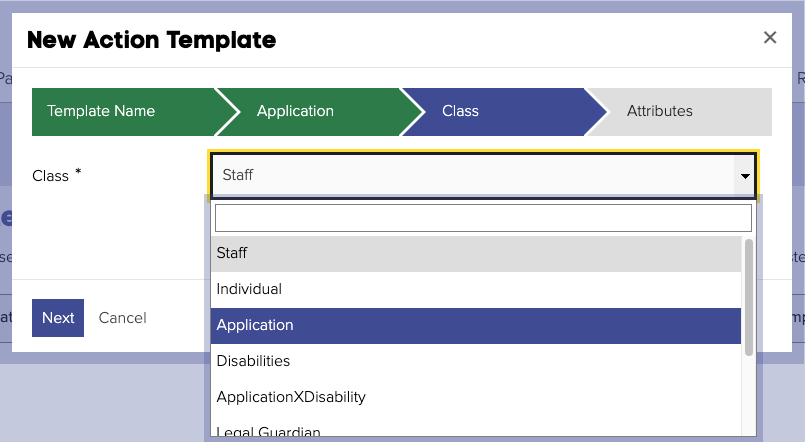WorkView: Update Object
In order to use the WorkView: Update Object action, you'll need to create a template, which specifies what information from the form to use to update the Object in WorkView, and the key of the Object to be updated.
To do this:
-
Navigate to Templates in the top navigation bar (under the form title).
-
Click Create Template.
-
A popover will open, asking which type of action we want to create a template for. Choose WorkView: Update Object under the Hyland OnBase section, and click Next.

-
You'll then be taken to the template builder for this action. It is also possible to access the template builder from within a rule, by choosing Create new... when selecting a template in a Then block.
-
Set the title of your template, and click Next. The title is simply used for identifying the template within the system, it is not presented to the portal user.

-
Select the WorkView Application in which the object to be updated using this template belongs, and click Next.

-
Select the WorkView Class of the object to be updated using this template, and click Next.
 tip
tipEnsure that the integration service user has the "Modify" permission enabled for the Class.
-
Finally, map the key of the Object to be updated, and complete the Attribute mappings.
The Object key can be mapped to any form response, variable or logic result. The class of the Object identified by this once the mapping is evaluated, must be the same as configured for the Class in the previous step.
See Attribute Mappings below for more details on mapping Attribute values.
When updating an Object, if an Attribute is not mapped, the existing Attribute value will be retained. If an Attribute is mapped, and the mapping evaluates to empty then the Attribute value will be removed.
-
Click Save to finish creating your template.
Once the template has been created, it will need to be activated by adding it to a rule which runs when the user submits the form.
Attribute Mappings
When mapping Attribute values, you can select any form response, variable or logic result, or you can enter manual text by typing it into the search box for the mapping and pressing the return key.
It is the responsibility of the user building the form to ensure that Attribute constraints (e.g. maximum length, data-type, mask, restricted values, etc) are satisfied by using suitable form components and validation, to ensure that action does not fail due to invalid Attribute values being supplied, or required Keywords being omitted. Help-text is provided for each Attribute detailing the data-type.
In order to populate the value of an attribute it must be present on a View or Filter for the Class in WorkView, which the integration service user has access to
There are several special cases to bear in mind when completing your Attribute mappings:
Default values
When creating an Object, if an Attribute has a default value using a sequence, it's mapping will be ignored. When updating an Object, the mapping provided is respected.
Date and DateTime Attributes
Best efforts will be made to convert the evaluated mapping value to a Date or DateTime value according to the data-type of the Attribute and the date format expected by the OnBase API, based on the locale set for the portal. If the evaluated value cannot be converted to a valid date, the Object will not be created/updated and an appropriate error will be output to the form action log.
Boolean Attributes
The following evaluated mapping values (case-insensitive) will be considered as true:
- true
- yes
- y
- 1
The following evaluated mapping values (case-insensitive) will be considered as false:
- false
- no
- n
- 0
If the evaluated value cannot be converted to a boolean value, the Object will not be created/updated and an appropriate error will be output to the form action log.
"Document" type Attributes
To map to an Attribute with a datatype of "Document", the evaluated mapping value must be the ID (handle) of an OnBase Document. There are several ways that this could be obtained:
-
If the form were linked to from a Document List widget using an Action Link, the Document ID would be passed into the form via the URL.
-
The Document ID could be provided, or looked up within the form submission.
-
The Document could be created using one of the Create Document form actions in the form, by adding it to the rule before the Create or Update Object action.
If the Document is created using the Create Document with generated PDF action, either the "Use value from a previous action" checkbox could be checked, or the Hyland OnBase - Document ID for generate PDF variable could be used, to provide the Document ID.
If the Document is created using the Create Document(s) with uploaded file(s) action, either the Hyland OnBase - First Document ID for an uploaded file or the Hyland OnBase - Last Document ID for an uploaded file could be used to provide the Document ID. Bear in mind that this action can result in multiple Documents being created, however only one Document ID can be provided for the Attribute value. In this case, it may therefore be better to relate the Documents to the Object via a common Keyword / Attribute value.
Relationship Attributes
To map to a Relationship Attribute, the evaluated mapping value must be the key of the Object which is to be related. There are several ways that this could be obtained:
- If the form were linked to from a Filter Results widget or Object details widget using an Action Link, the Object key would be passed into the form via the URL.
- The Object key could be retrieved during the form submission, using one (or a combination) of:
- The related Object could be created within the same form, by adding a WorkView: Create Object action earlier in the rule, by checking the "Use value from a previous action" checkbox.
Mapping to a checkbox question response
Where the user has checked multiple checkboxes, the resulting Attribute value will be a comma separated list of the selected options.
Attributes with Unique Indexes
If when creating an Object where there is a "Unique" Index on a given attribute, a value is provided that is already in use by another Object, currently this will be reported as a success, however with an invalid Object key returned. An improvement to the integration to detect this situation is currently being developed. This could be prevented by using the Hyland OnBase - WorkView Filter Result logic to determine if the attribute value is already in use before creating the Object, and configuring rules and/or page branching to act accordingly.